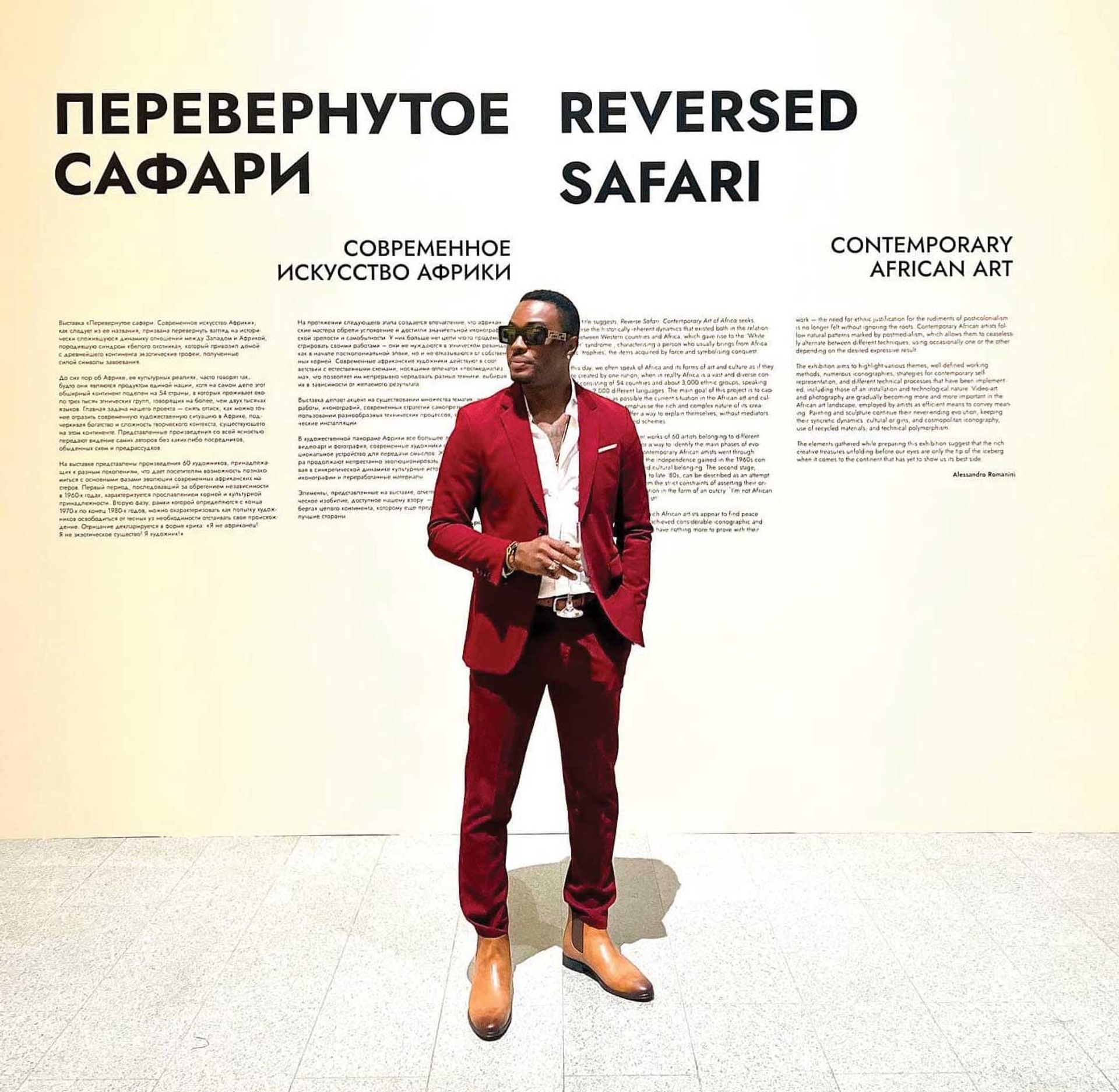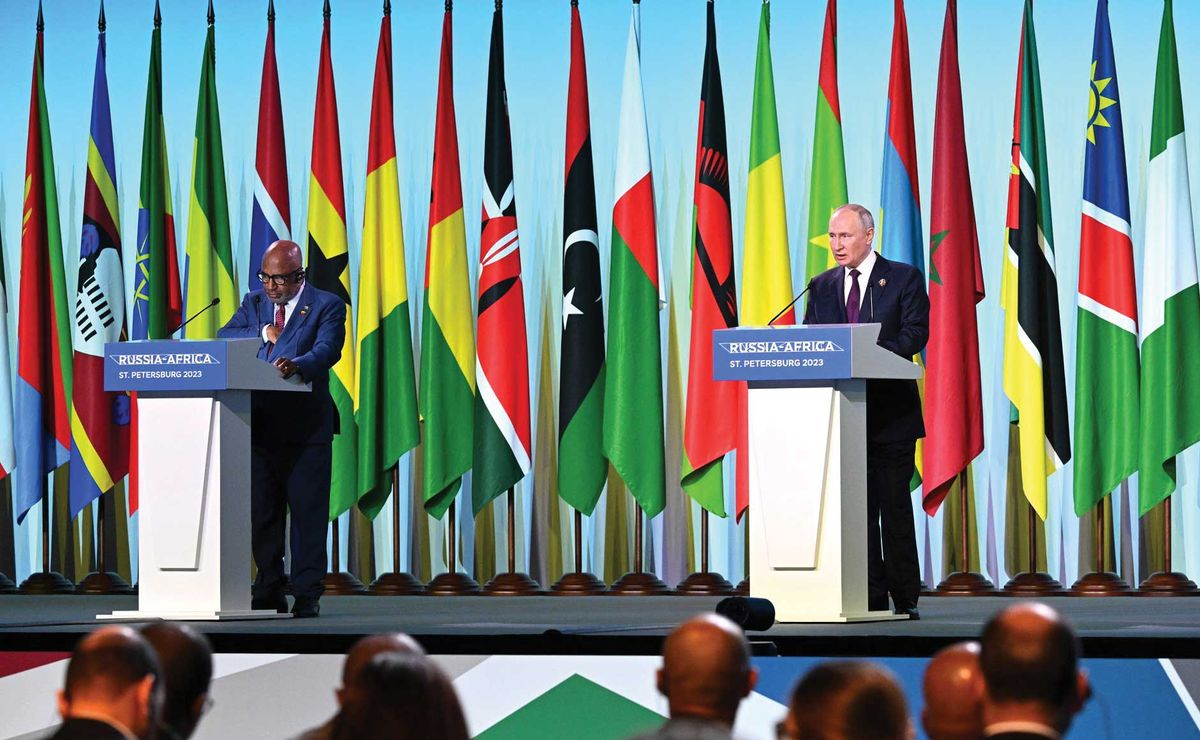African art is booming—in Russia. As the Kremlin has moved to strengthen its trade and diplomatic ties with African countries, rekindling a Soviet soft power campaign on the continent, Russian museums and galleries are pivoting too. The wave of displays is partly filling a gap as culture venues have been frozen out of exchanges with their European counterparts since Russia’s invasion of Ukraine. Russian-US museum partnerships have been suspended since 2010 due to a dispute over the Schneerson Library of Jewish texts.
The trend mirrors the African art boom of recent years in Europe and the US, but it is also on message with the Kremlin’s evolving foreign policy. Reversed Safari, Russia’s first major exhibition of African art, took place last summer in St Petersburg’s Manege Central Exhibition Hall, with more than 300 works by 49 African and 14 Russian artists. The State Russian Museum, run since April by a Putin loyalist, Alla Manilova, held a concurrent exhibition, Africa in Russian Art. Both shows were associated with Putin’s second Russia-Africa summit held in the city in July. The declaration of the first summit in 2019 had included a pledge to facilitate cooperation in culture, education and tourism, among other areas.
Meanwhile, the international network of “Russkii dom” cultural centres is rapidly expanding in Africa, most recently in Burkina Faso and Chad. The Institute for the Study of War, based in Washington, DC, last month reported concerns raised by Ukrainian officials that the centres, which promote the study of Russian and cultural exchange programmes, are being used to “promote Russian propaganda and conduct ‘subversive work’ abroad”. Though they are often billed as NGOs, they come under the aegis of Rossotrudnichestvo, an agency run by Russia’s foreign affairs ministry that is currently under EU sanctions for “disseminating the Kremlin’s narratives” via “agents of influence”.
Reversed Safari, a pan-African exhibition featuring artists from nearly 20 countries, has been billed as “anti-colonial in its essence”. It moved in October to the State Museum of Fine Arts in Kazan, the capital of the Republic of Tatarstan, where it runs until 4 February.
Some artists, such as Mederic Turay from Côte d’Ivoire, posted on social media about participating in the St Petersburg show. Others, including the Ghanaian sculptor El Anatsui, said they had no idea their works were included, according to the US-funded broadcaster Radio Liberty. Nnenna Okore, an Australian-born Nigerian artist based in Chicago, confirmed to The Art Newspaper that she had not been informed.
The exhibition’s co-curators are Alessandro Romanini, an Italian specialist in African art, and Yulia Aksenova, formerly of the State Tretyakov Gallery and Garage Museum of Contemporary Art. Triumph, a commercial gallery in Moscow with ties to Russia’s elites, is also listed as an organiser. Lis10 Gallery in Paris and Arezzo, Italy, which represents many of the artists, promoted the exhibition on its website and social media.
Concerns over lack of artists’ consent
In an interview with Radio Liberty, the Ukrainian-born art historian (and contributor to The Art Newspaper) Konstantin Akinsha raised concerns over the lack of consent from many of the artists involved, due to their works being sourced from private lenders and Lis10. He described the exhibition as an “amazingly successful propaganda effort” offering “politically correct decorations for Russian intentions in Africa”.
Contacted by The Art Newspaper, Turay says he was motivated to participate in Reversed Safari by the similarities between Africa and Russia and the potential for further cross-cultural collaborations between African and Russian artists. While he recognises that the show could be used for political ends, he says: “It’s not my responsibility as an artist to judge each side, but to have a higher positive statement.”

Ivorian artist Mederic Turay has work in the exhibition Reversed Safari
Courtesy of the artist
Triumph Gallery’s co-founder Emelyan Zakharov told the Russian state-owned RIA Novosti news agency that Italian collectors readily loaned works for the exhibition and that “cultural dialogue continues despite all the political difficulties”.
Reversed Safari also features pieces from a collection of traditional African art amassed by the Romanian-born Brazilian photographer Eddy Novarro, who was a friend of Pablo Picasso and other Modern masters. In 2003, Novarro’s Russian widow, Tatiana, transferred the collection to the estate of Vasily Polenov, a revered Russian landscape painter.
Natalia Polenova, Polenov’s great-granddaughter and the director of his museum and former country home in the Tula region, tells The Art Newspaper that the “renaissance of interest in Africa” has been a boon to the Novarro collection. Eighty-six pieces were recently exhibited at the Yaroslavl Art Museum and African sculptures and masks from the collection are on show at the Polenov museum until 14 April.
Late last year, a gallery located within Russia’s Chamber of Commerce and Industry in Moscow exhibited around 200 works from another single-owner collection of African art with 20th-century roots. Most of the works owned by Marina Schmidt date from 1950-80 and were purchased from Soviet specialists who worked in African countries at the time, according to a press statement.
A Soviet-era collection of Congolese art was the subject of a recent exhibition at Moscow’s State Museum of Oriental Art, focused on the Poto-Poto school of painting. In the summer the museum’s director, Alexander Sedov, also announced plans to open a venue dedicated to African culture in a former Moscow contemporary arts centre that had been shut down for political reasons.
Russia’s official news agency Tass reports that the new museum will advance the “strategic partnership” between Russia and the African continent, looking back at the role of the USSR and positioning Russia today as “its successor in supporting the struggle of African peoples for independence”.


